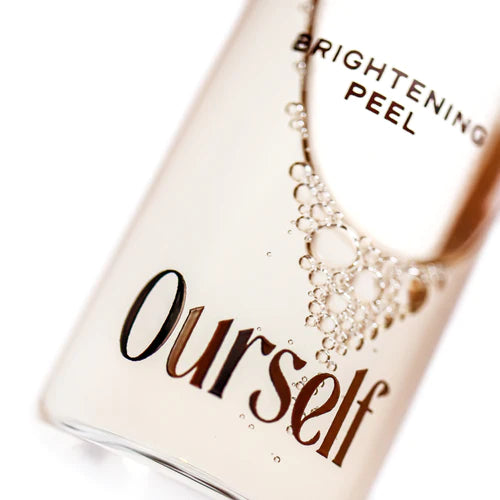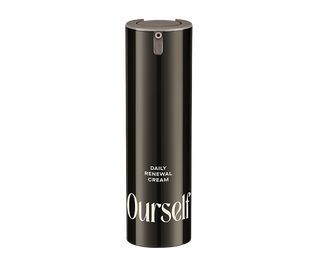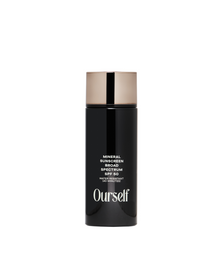
What is a chemical peel, and how can you do one at home? Here, everything you need to know about DIY chemical peels.
Ourself’s at-home chemical peels are a great way to exfoliate, improve skin discoloration, and texture. Try incorporating an at-home chemical peel into your skincare routine to get clinical-level results, without the clinic.
What Is a Chemical Peel?
Chemical peels are a type of skincare treatment in which a chemical solution is applied to the face, neck, or hands to improve texture or pigmentation. Sometimes, chemical peels are referred to as derma peeling or chemexfoliation.
Chemical peels cause trauma to the skin–while this might sound scary, this reaction causes the outermost layers of the skin to peel away and reveal a complexion that is both smoother in texture and appearance. People often get chemical peels to treat dark spots, pigmentation issues, dullness, fine lines, and wrinkles.
How Often Can You Do Chemical Peels?
Depending on the strength of the chemical peel, you can perform one every two to four weeks. Some more intensive treatments require a longer wait time. It is important to let the skin fully recover in between peels to ensure only the outermost layer of skin is exfoliated.
You know your skin best. If you have very sensitive skin, wait longer before performing another chemical peel. If you’re a peeling pro, you can probably get away with a bi-monthly regimen of peels to help your skin shine. As always, you can consult a dermatologist before starting an at-home skincare regimen to get guidance and advice.
What Are the Side Effects of Chemical Peels?
Depending on the strength of the chemical peel, side effects can vary. You might experience redness, mild irritation, and/or discoloration for a couple of days with a light or medium peel.
Some people experience almost no side effects with superficial chemical peels and only have a bit of redness for an hour after the treatment. Others may also experience mild skin peeling.
With a deep chemical peel, these side effects might last for longer, and you might experience more severe irritation. You will likely experience skin peeling and redness that can last upwards of a week, so be sure to do a strong peel when you know you can avoid sun exposure following the treatment.
Rarely, people might experience scarring, infection, or changes in skin color. Changes in skin tone may occur in people of color who have a higher melanin content.
How Do Chemical Peels Work?
In essence, chemical peels peel away the outer layers of the skin to reveal the new layers of skin underneath. While this might sound like something out of a horror film, don’t worry. Chemical peels can treat a wide variety of common skin concerns at home without long recovery times.
Some types of chemical peels are more intense than others, depending on their depth. Your dermatologist can help determine which strength is right for you, depending on the level of your concerns.
What Do Chemical Peels Treat?
Chemical peels can be helpful for many different skin types and concerns. If you have dry skin, you can use a chemical peel to exfoliate away scaly or flaky patches of skin that contribute to a dull complexion.
People with oily skin or acne-prone skin might opt for a chemical peel treatment for their acne or acne scarring. Folks with aging skin can see chemical peel results for age spots, wrinkles, and fine lines.
More intense forms of professional chemical peels can even treat actinic keratosis, which are scaly, pre-cancerous spots. Each depth of chemical peel has different use cases, so make sure you opt for the treatment intensity that is right for your concerns.
Our Brightening Peel targets larger areas to reduce fine lines, pores, and dull skin to reveal a brighter, more even texture with 34% glycolic acid.
What Are the Different Kinds of Chemical Peels?
There are three main types of chemical peels: light, medium, and deep. As the name implies, a light chemical peel removes the epidermis and is often used to ease common skin concerns like uneven tone, fine lines, and blemishes. Often, at-home chemical peels are considered light chemical peels.
Medium chemical peels target both the epidermis and portions of the dermis. This chemical peel is also used to minimize the appearance of wrinkles, unevenness, and acne scarring. Finally, deep chemical peels are intensive treatments used to help address scars, deep wrinkles, and even precancerous cells. This type of peel will require more downtime than lighter peels.
At-home and professional treatments use different types of acids to perform chemical peels.
Glycolic Acid Peel
Glycolic acid is a powerful ingredient that can treat a variety of skin concerns when applied in peel form. At Ourself, our 34% glycolic acid Brightening Peel gives an all-over glow and brightness to the skin, revealing a more even skin texture and tone.
Glycolic acid can also help support healthy cell turnover by removing dead skin cells from the surface of the skin.
Why 34%? Our team of Ourself scientists determined that this concentration of glycolic acid is the perfect balance when it comes to both results and recovery. We wanted to formulate a product that would give you the treatment you need without long bouts of redness or blotchiness.
We also pair our glycolic acid with TXA, or tranexamic acid, to reduce redness and hyperpigmentation; phytic acid, which is an antioxidant that reduces redness and inflammatory hyperpigmentation; and vitamin c to brighten the skin.
Lactic Acid Peel
If you have sensitive skin, lactic acid can be a lightweight starter peel. While you will not see as strong results with a lactic as other types of chemical peel, it can be a good introduction to the world of chemical peels.
Lactic acid helps aid with exfoliation to smooth skin and reveal a healthy glow. Additionally, lactic acid can help with fine lines and small wrinkles. If you suffer from extremely dry skin, you might opt for a lactic acid peel because it is more hydrating than other peel options.
Salicylic Acid Peel
For acne-prone skin, a salicylic acid peel is a great option. Salicylic is most known for supporting proper sebum production, easing blackheads, and unclogging pores, but it can also help people who are dealing with sun damage, dark spots, and other skin concerns.
We love incorporating other acids like salicylic and lactic acid into our peels to maximize results without disrupting your skin’s natural state. Our team of scientists specifically developed each peel’s formula to ensure the perfect balance of acids.
Other Types of Chemical Peels
There are many different types of acids that you might find in chemical peels. At-home treatments can include mandelic acid peels, enzyme peels, Jessner’s peels, and more. Before proceeding with any chemical peels, it is a good idea to talk to your dermatologist about where to start to keep your skin safe and healthy.
How Do At-Home Chemical Peels Compare to Professional Chemical Peels?
Over-the-counter chemical face peel products come in different forms, like peel pads or a vial of peeling solution. Here at Ourself, we package our peels in a small bottle. That way, if you have extra solution leftover after your chemical peel, you can save it for another treatment within twelve months.
How Can I Do a Chemical Peel at Home?
When you do a skin treatment at home, it is important to take all necessary precautions—especially with intensive treatments like chemical peels. Prioritize your skin’s safety, and make sure that you follow package directions carefully to avoid skin damage.
Every at-home chemical peel will have slightly different instructions and precautions, so read the directions thoroughly. If you are a person of color with a deeper skin tone, certain peels might have different instructions or advice to ensure you preserve your skin’s rich, natural tone.
The Patch Test
Everyone reacts to skin treatments differently, so it is important to do a patch test with any type of chemical skin peel before applying it to your whole face. Patience is key when it comes to chemical peels.
To do a patch test, you should take a small amount of the chemical peel you intend to use and apply it to a discreet area of your skin. Often, people do patch tests on their wrists or neck. Follow the peel instructions, then wait 48-96 hours to see if you have an allergic reaction.
If you do not have an adverse reaction to the chemical peel, you can apply it to the skin on your face. Start with a lightweight chemical peel before taking the plunge with an intensive treatment.
Applying a Chemical Peel
For our href="https://www.ourself.com/collections/clinical-peels-lasers/products/brightening-peel">Brightening Peel, it is important to avoid facial treatments that have retinoid, retinol, AHAs, and BHAs two to four weeks before performing the chemical peel. You should also make sure to moisturize and protect your skin with products like our Daily Renewal Cream and Mineral Sunscreen.
Before performing your peel, make sure that you cleanse your skin with a gentle cleanser that does not contain acids. Then, follow the specific instructions that come with your chemical peel of choice. With strong chemicals, it is always important to follow instructions to keep your skin safe.
If it’s your first time doing a chemical peel, tend toward the shortest amount of recommended time. You can always increase the time you leave your peel on for future applications. Most peels recommend avoiding the eye and lip area.
How Should I Take Care of My Skin After a Chemical Peel?
Since skin may be sensitive after a chemical peel, treat it with gentle products that provide protection and hydration. Ensure you’re using a daily SPF to protect against sun damage, like Ourself’s Mineral Sunscreen.
Additionally, incorporate a nourishing moisturizer into your skincare routine after a chemical peel to help repair your moisture barrier. A cream that contains hyaluronic acid like our Daily Renewal Cream can even help soothe freshly-peeled skin and aid in recovery.
There are several ingredients to avoid in the 24 hours following a chemical peel to ensure you do not damage your skin. Chemical peels are an intensive treatment—even the lightweight ones—so you need to make sure that you properly care for your skin post-treatment.
Post-peel, steer clear of alpha hydroxy acids (AHAs) and beta hydroxy acids (BHAs), as well as any prescription tretinoins, vitamin c serums, retinoids, low pH serums, or other scrubs and chemical exfoliation.
As with any skin treatment, you should follow the product instructions for application and aftercare. Depending on the active ingredients, there may be additional ingredients that you should avoid following a chemical peel.
Are Chemical Peels Right for Me?
Chemical peels can benefit many different skin types and fight against several skin concerns, from signs of aging to sun damage to excess dryness or oiliness. However, there are some situations in which you should avoid a chemical peel.
When Should I Avoid Chemical Peels?
If you have very sensitive skin or certain skin conditions, it is a good idea to speak with your doctor or dermatologist before getting a chemical peel or doing one at home. Additionally, you should avoid doing a chemical peel if you are actively treating a skin infection or a sunburn.
If you take prescription medication for acne or another skin condition, consult your dermatologist to make sure a chemical peel won’t irritate your skin.
Additionally, if you are pregnant or might be pregnant, you should speak with your dermatologist before proceeding with any new skincare treatment. Most derms recommend avoiding chemical peels while pregnant because of any acid that might make its way into the bloodstream, but you and your doctor can determine what is safe for your situation.
Conclusion
At-home chemical peels are a great option to harness the power of dermatological treatments without long wait times at the doctor’s office. Chemical treatments like our Brightening Peel are highly effective, potent treatments.
Since chemical peels can be intense on the skin, make sure that you follow usage instructions carefully and protect your skin before and after using a chemical peel.
When in doubt, ask your dermatologist before performing your own at-home chemical peel to ensure you get the glowing skin you desire sans damage or irritation.
>
Sources:
Chemical Peels: Types of Peels, Conditions Treated, What to Expect | Cleveland Clinic
Skin Resurfacing Chemical Peels - StatPearls | NCBI Bookshelf

